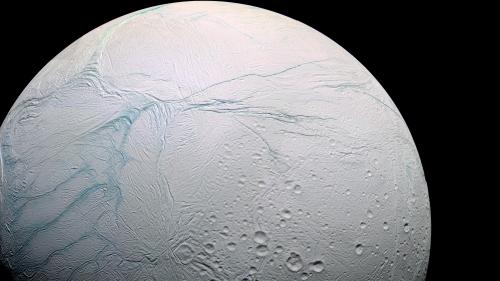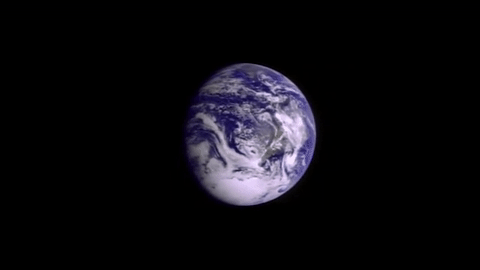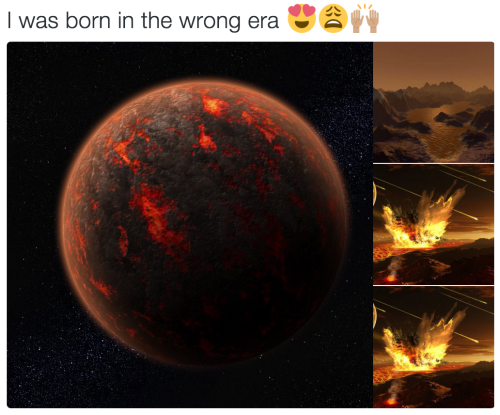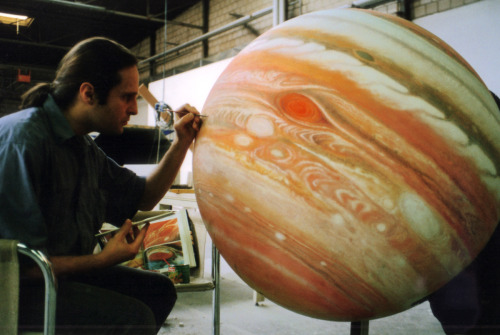A Stunning High Res Photo Of Saturn’s Moon Enceladus

A stunning high res photo of Saturn’s Moon Enceladus
More Posts from Intergalacticnerd and Others
7 Facts That Will Make You Feel Very Small

Earth, our home planet, is the fifth largest planet in our solar system and the only planet we know of where life exists. Even though Earth seems extremely large to us, it is actually a tiny spec in the vast expanse of the universe. Here are 7 space facts that will make you feel very small.

1. Our sun is one of at least 100 BILLION stars, just in the Milky Way. Scientists calculate that there are at least 100 billion galaxies in the observable universe, each one brimming with stars. There are more stars than grains of sand on all of Earth’s beaches combined.
In 1995, the first planet beyond our solar system was discovered. Now, thousands of planets orbiting sun-like stars have been discovered, also known as exoplanets.

2. The Milky Way is a huge city of stars, so big that even at the speed of light (which is fast!), it would take 100,000 years to travel across it.

3. Roughly 70% of the universe is made of dark energy. Dark matter makes up about 25%. The rest — everything on Earth, everything ever observed with all of our instruments, all normal matter adds up to less than 5% of the universe.

4. If the sun were as tall as a typical front door, Earth would be the size of a nickel.

5. The sun accounts for almost all of the mass in our solar system. Leaving .2% for all the planets and everything else.

6. Edwin Hubble discovered that the Universe is expanding and that at one point in time (14 billion years ago) the universe was all collected in just one point of space.

7. Four American spacecraft are headed out of our solar system to what scientists call interstellar space. Voyager 1 is the farthest out — more than 11 billion miles from our sun. It was the first manmade object to leave our solar system. Voyager 2, is speeding along at more than 39,000 mph, but will still take more than 296,000 years to pass Sirius, the brightest star in our night sky.
Feeling small yet? Here’s a tool that will show you just how tiny we are compared to everything else out there: http://imagine.gsfc.nasa.gov/features/cosmic/earth.html
Make sure to follow us on Tumblr for your regular dose of space: http://nasa.tumblr.com

Saturn and its largest moon reflect their true colors http://ift.tt/1lnhm8l



Psychedelic Pluto : New Horizons scientists made this false color image of Pluto using a technique called principal component analysis to highlight the many subtle color differences between Plutos distinct regions.
js

why am i sad
I don’t have any answer to this but I hope you feel better :’( But here is a great example of astronomy and how awesome humanity can be

some of my favourite absolutely SICK facts about the trappist-1 exoplanets: - theyre all very close to one another and to their star, so the length of a year on them varies from 1 to 20 DAYS - since they’re so close, the star appears a lot bigger than our sun from earth, and from one planet you could easily see the rest, some would even appear bigger than the moon from earth. you could literally see the surface of another planet with a naked eye!!! - they’re tidally locked to their star like our moon is locked to earth, meaning only one side of a planet ever faces the star, and on the other side it’s always night. the sun never sets or rises on any of the planets - the star is red, so the sunlight is red/orange, meaning if, for example, plants were to grow there, they could be black and that’s just what we know now, imagine how much cool stuff we have yet to discover about the trappist-1 system
The Shakespearean Moons of Uranus
This weekend marks the 400th anniversary of Shakespeare’s death, and we’re highlighting the moons of Uranus; some of which are named after characters from his works.

While most of the moons orbiting other planets take their names from Greek mythology, Uranus’ moons are unique in bing named for Shakespearean characters, along with a couple of them being named for characters from the works of Alexander Pope.

Using the Hubble Space Telescope and improved ground-based telescopes, astronomers have discovered a total of 27 known moons around Uranus.
Here’s a sampling of some of the unique aspects of the moons:
Miranda

Shakespearean work: The Tempest
Miranda, the innermost and smallest of the five major satellites, has a surface unlike any other moon that’s been seen. It has a giant fault canyon as much as 12 times as deep as the Grand Canyon, terraced layers and surfaces that appear very old, and others that look much younger.
Ariel

Shakespearean work: The Tempest
Ariel has the brightest and possibly the youngest surface among all the moons of Uranus. It has a few large craters and many small ones, indicating that fairly recent low-impact collisions wiped out the large craters that would have been left by much earlier, bigger strikes. Intersecting valleys pitted with craters scars its surface.
Oberon

Shakespearean work: A Midsummer Night’s Dream
Oberon, the outermost of the five major moons, is old, heavily cratered and shows little signs of internal activity. Unidentified dark material appears on the floors of many of its craters.
Cordelia and Ophelia

Shakespearean works: Cordelia - King Lear; Ophelia - Hamlet
Cordelia and Ophelia are shepherd moons that keep Uranus’ thin, outermost “epsilon” ring well defined.
Between them and miranda is a swarm of eight small satellites unlike any other system of planetary moons. This region is so crowded that astronomers don’t yet understand how the little moons have managed to avoid crashing into each other. They may be shepherds for the planet’s 10 narrow rings, and scientists think there must be still more moons, interior to any known, to confine the edges of the inner rings.
Want to learn more about all of Uranus’s moons? Visit: http://solarsystem.nasa.gov/planets/uranus/moons
Check out THIS blog from our Chief Scientist Ellen Stofan, where she reflects on the life and legacy of William Shakespeare on the 400th anniversary of his death on April 23, 1616.
Make sure to follow us on Tumblr for your regular dose of space: http://nasa.tumblr.com
-
 worldtravelergurl reblogged this · 9 months ago
worldtravelergurl reblogged this · 9 months ago -
 worldtravelergurl liked this · 9 months ago
worldtravelergurl liked this · 9 months ago -
 carnalreincarnated liked this · 1 year ago
carnalreincarnated liked this · 1 year ago -
 inhersoulitunesss liked this · 1 year ago
inhersoulitunesss liked this · 1 year ago -
 zombimanos reblogged this · 1 year ago
zombimanos reblogged this · 1 year ago -
 thomasbolt reblogged this · 1 year ago
thomasbolt reblogged this · 1 year ago -
 sircrowley liked this · 1 year ago
sircrowley liked this · 1 year ago -
 typocode liked this · 1 year ago
typocode liked this · 1 year ago -
 hotspothutspot liked this · 1 year ago
hotspothutspot liked this · 1 year ago -
 blancpain1735-fan-luxembourg liked this · 1 year ago
blancpain1735-fan-luxembourg liked this · 1 year ago -
 slimaaronswithashotgun reblogged this · 1 year ago
slimaaronswithashotgun reblogged this · 1 year ago -
 nrblq reblogged this · 2 years ago
nrblq reblogged this · 2 years ago -
 silverloke reblogged this · 2 years ago
silverloke reblogged this · 2 years ago -
 jacko-shadow liked this · 2 years ago
jacko-shadow liked this · 2 years ago -
 phiilosophia reblogged this · 2 years ago
phiilosophia reblogged this · 2 years ago -
 zeitungspapierhut reblogged this · 2 years ago
zeitungspapierhut reblogged this · 2 years ago -
 zeitungspapierhut liked this · 2 years ago
zeitungspapierhut liked this · 2 years ago -
 irennestero reblogged this · 2 years ago
irennestero reblogged this · 2 years ago -
 irennestero liked this · 2 years ago
irennestero liked this · 2 years ago -
 mercuryislove reblogged this · 2 years ago
mercuryislove reblogged this · 2 years ago -
 deceivedestiny reblogged this · 2 years ago
deceivedestiny reblogged this · 2 years ago -
 in-luce-lunae reblogged this · 2 years ago
in-luce-lunae reblogged this · 2 years ago -
 rewritethedracula reblogged this · 2 years ago
rewritethedracula reblogged this · 2 years ago -
 calmingvisualz reblogged this · 2 years ago
calmingvisualz reblogged this · 2 years ago -
 sadf--k liked this · 2 years ago
sadf--k liked this · 2 years ago -
 calliope-star liked this · 2 years ago
calliope-star liked this · 2 years ago -
 setonfire13 liked this · 2 years ago
setonfire13 liked this · 2 years ago -
 cyber-fucc reblogged this · 2 years ago
cyber-fucc reblogged this · 2 years ago -
 magical-alien liked this · 2 years ago
magical-alien liked this · 2 years ago -
 from-a-distant-end reblogged this · 2 years ago
from-a-distant-end reblogged this · 2 years ago -
 thesadrooms reblogged this · 2 years ago
thesadrooms reblogged this · 2 years ago -
 thesadrooms liked this · 2 years ago
thesadrooms liked this · 2 years ago -
 hulouhoop reblogged this · 2 years ago
hulouhoop reblogged this · 2 years ago -
 animaltrucking reblogged this · 2 years ago
animaltrucking reblogged this · 2 years ago -
 rewritethedracula liked this · 2 years ago
rewritethedracula liked this · 2 years ago -
 minidelusions liked this · 2 years ago
minidelusions liked this · 2 years ago -
 swaddle reblogged this · 2 years ago
swaddle reblogged this · 2 years ago -
 swaddle liked this · 2 years ago
swaddle liked this · 2 years ago
"Astronomy compels the soul to look upwards and leads us from this world to another." - Plato
147 posts
